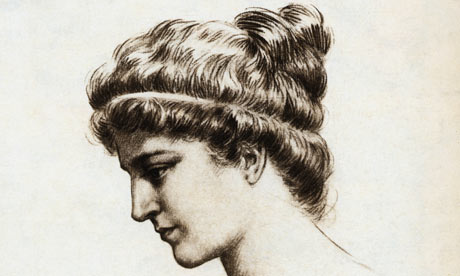HYPATIA

A mathematician and philosopher, Hypatia was educated in Athens and Italy. During 400 A.D., she became the head of the Platonist school at Alexandria. She imparted knowledge equally to all students including Christians, pagans and foreigners.
She was the daughter of Theon of Alexandria who was a teacher of mathematics with the Museum of Alexandria in Egypt. A center of Greek intellectual and cultural life, the Museum included many independent schools and the great library of Alexandria where Hypatia was the last librarian.
Hypatia studied with her father, and with many others including Plutarch the Younger. She taught philosophy based on Neoplatonism, which based on the teachings of Plato. She wrote on mathematics, astronomy and philosophy, including about the motions of the planets, about number theory and about conic sections.
Hypatia corresponded with and hosted scholars from others cities. Synesius, Bishop of Ptolemais, was one of her correspondents and he visited her frequently. Hypatia was a popular lecturer, drawing students from many parts of the empire.
From the little historical information about Hypatia that survives, it appears that she invented the plane astrolabe, the graduated brass hydrometer and the hydroscope, with Synesius of Greece, who was her student and later colleague.
Hypatia dressed in the clothing of a scholar or teacher, rather than in women's clothing. She moved about freely, driving her own chariot, contrary to the norm for women's public behavior. She exerted considerable political influence in the city.
Orestes, the governor of Alexandria, like Hypatia, was a pagan (non-Christian). Orestes was an adversary of the new Christian bishop, Cyril, a future saint. Orestes, according to the contemporary accounts, objected to Cyril expelling the Jews from the city, and was murdered by Christian monks for his opposition.
Cyril probably objected to Hypatia on a number of counts: She represented heretical teachings, including experimental science and pagan religion. She was an associate of Orestes. And she was a woman who didn't know her place. Cyril's preaching against Hypatia is said to have been what incited a mob led by fanatical Christian monks in 415 to attack Hypatia as she drove her chariot through Alexandria. They dragged her from her chariot and, according to accounts from that time, stripped her, killed her, stripped her flesh from her bones, scattered her body parts through the streets, and burned some remaining parts of her body in the library of Caesareum. She was accused of witchcraft and godlessness and of causing religious turmoil.
Hypatia's students fled to Athens, where the study of mathematics flourished after that. The Neoplatonic school she headed continued in Alexandria until the Arabs invaded in 642.
When the library of Alexandria was burned by the Arab conquerors, used as fuel for baths, the works of Hypatia were destroyed. We know her writings today through the works of others who quoted her -- even if unfavorably -- and a few letters written to her by contemporaries.
She was the daughter of Theon of Alexandria who was a teacher of mathematics with the Museum of Alexandria in Egypt. A center of Greek intellectual and cultural life, the Museum included many independent schools and the great library of Alexandria where Hypatia was the last librarian.
Hypatia studied with her father, and with many others including Plutarch the Younger. She taught philosophy based on Neoplatonism, which based on the teachings of Plato. She wrote on mathematics, astronomy and philosophy, including about the motions of the planets, about number theory and about conic sections.
Hypatia corresponded with and hosted scholars from others cities. Synesius, Bishop of Ptolemais, was one of her correspondents and he visited her frequently. Hypatia was a popular lecturer, drawing students from many parts of the empire.
From the little historical information about Hypatia that survives, it appears that she invented the plane astrolabe, the graduated brass hydrometer and the hydroscope, with Synesius of Greece, who was her student and later colleague.
Hypatia dressed in the clothing of a scholar or teacher, rather than in women's clothing. She moved about freely, driving her own chariot, contrary to the norm for women's public behavior. She exerted considerable political influence in the city.
Orestes, the governor of Alexandria, like Hypatia, was a pagan (non-Christian). Orestes was an adversary of the new Christian bishop, Cyril, a future saint. Orestes, according to the contemporary accounts, objected to Cyril expelling the Jews from the city, and was murdered by Christian monks for his opposition.
Cyril probably objected to Hypatia on a number of counts: She represented heretical teachings, including experimental science and pagan religion. She was an associate of Orestes. And she was a woman who didn't know her place. Cyril's preaching against Hypatia is said to have been what incited a mob led by fanatical Christian monks in 415 to attack Hypatia as she drove her chariot through Alexandria. They dragged her from her chariot and, according to accounts from that time, stripped her, killed her, stripped her flesh from her bones, scattered her body parts through the streets, and burned some remaining parts of her body in the library of Caesareum. She was accused of witchcraft and godlessness and of causing religious turmoil.
Hypatia's students fled to Athens, where the study of mathematics flourished after that. The Neoplatonic school she headed continued in Alexandria until the Arabs invaded in 642.
When the library of Alexandria was burned by the Arab conquerors, used as fuel for baths, the works of Hypatia were destroyed. We know her writings today through the works of others who quoted her -- even if unfavorably -- and a few letters written to her by contemporaries.
Source:
http://womenshistory.about.com/od/hypati1/a/hypatia.htm
http://womenshistory.about.com/od/hypati1/a/hypatia.htm
0 (mga) komento:
Mag-post ng isang Komento